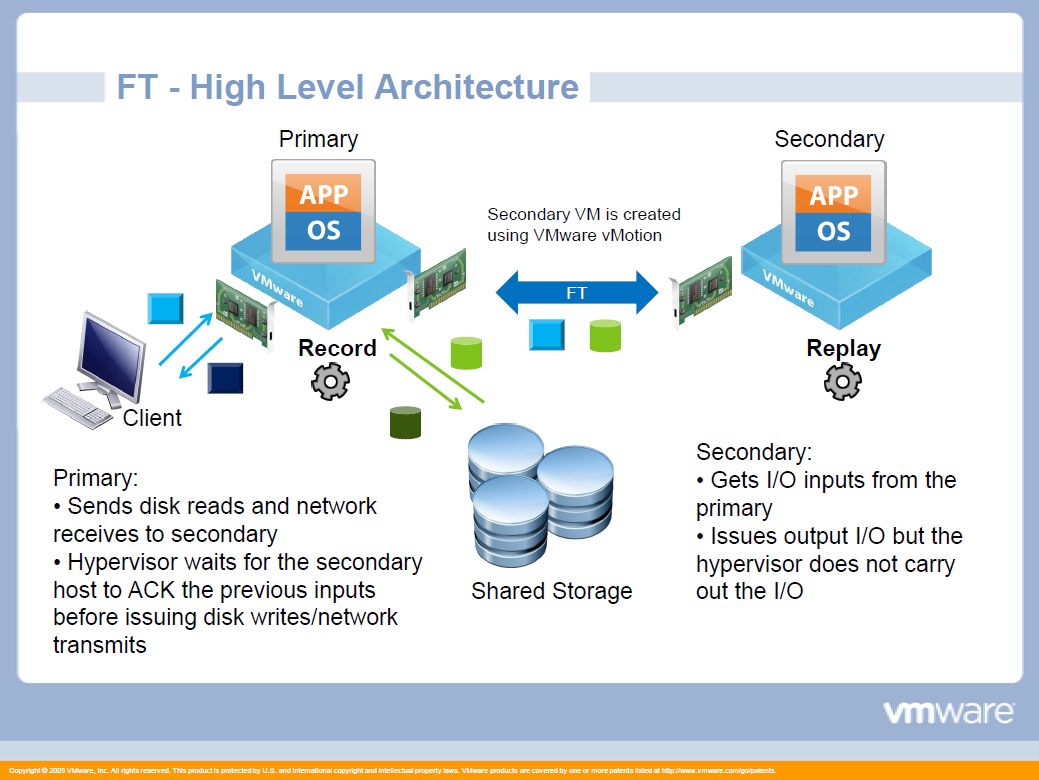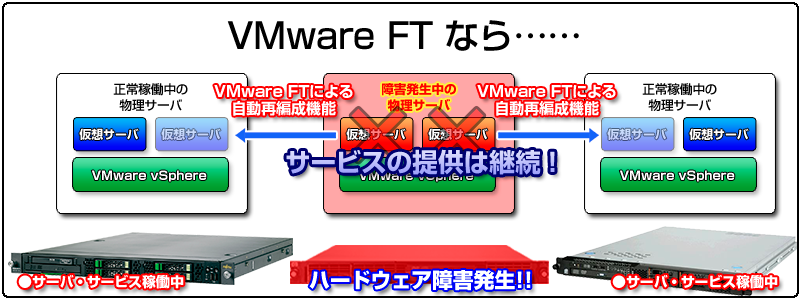

Hard disk 2: Depends on the storage volume to be used as shared storage – Thick Provisioned Eager Zeroed. Hard disk 1: 100 GB for OS (recommended) – Thick Provisioned Eager Zeroed. Network adapter for Management should be of the E1000 type. NOTE: Network adapters for iSCSI and Sync should be of the VMXNET3 type. RAM: at least 4 GB (plus the size of the RAM cache if it is planned to be used) reserved for the VM ĬPUs: at least 4 virtual processors with 2 GHz reserved StarWind VMs on ESXi hosts should be configured with the following settings:
#VMWARE VSPHERE 6.5 FAULT TOLERANCE WINDOWS#
Repeat steps 1-3 for any other links intended for Synchronization and iSCSI/Heartbeat traffic on ESXi hosts.Ĭreate Virtual Machines (VMs) on each ESXi host with supported Windows Server OS for StarWind VSAN (see system requirements: ) and further StarWind VSAN installation. Add a Virtual Machine Port Groups on the vSwitch for iSCSI traffic (vSwtich1) and on the vSwitch for Synchronization traffic (vSwitch2).Ĥ. Create a VMKernel port for the iSCSI/ StarWind Heartbeat channel.ģ. Using VMware ESXi web console, create two standard vSwitches: one for the iSCSI/ StarWind Heartbeat channel (vSwitch1) and the other one for the Synchronization channel (vSwitch2).Ģ. Additionally, vMotion can be enabled on VMKernel ports.ġ. NOTE: It is recommended to set MTU to 9000 on vSwitches and VMKernel ports for iSCSI and Synchronization traffic. Static IP addresses should be assigned to VMKernel ports. VMKernel port should be created only for iSCSI traffic. NOTE: Virtual Machine Port Group should be created for both iSCSI/ StarWind Heartbeat and the Synchronization vSwitches. All actions below should be applied to each ESXi server. Hyperconverged Appliance from StarWind HCA DatasheetĬonfigure network interfaces on each node to make sure that Synchronization and iSCSI/StarWind heartbeat interfaces are in different subnets and connected physically according to the network diagram above. We’ll also migrate your workloads at no extra cost.ĭramatically decrease your CapEx, OpEx, and IT management costs, while visibly increasing return on investment (ROI) with hyperconvergence for ROBO, SMB & Edge from StarWind. Everything’s operated through a neat web UI. All your systems will be “babysitted” by StarWind 24/7/365, troubleshooting any concerns without your involvement.
#VMWARE VSPHERE 6.5 FAULT TOLERANCE UPGRADE#
You don’t need anything else to build a budget-friendly new IT infrastructure or upgrade an existing one. StarWind HyperConverged Appliance is a turnkey hyper-converged hardware platform fitted into a small two-node footprint. Synchronization and iSCSI/Heartbeat links can be connected either via redundant switches or directly between the nodes. NOTE: Do not use ISCSI/Heartbeat and Synchronization channels over the same physical link. On each node, network interfaces to be used for Synchronization and iSCSI/StarWind heartbeat should be in different subnets and connected directly according to the network diagram above.

StarWind VSAN should be installed on the Windows Server operating system deployed as VM on each host.ģ. ESXi hypervisor should be installed on each host.Ģ. The diagram below illustrates the network and storage configuration of the solution.ġ. StarWind Virtual Tape Library (VTL) OEM.StarWind Virtual Tape Library Appliance (VTLA).StarWind HyperConverged Appliance (HCA).StarWind RDMA Performance Benchmark (rPerf).Hope you enjoyed this post and don’t forget to share and comment. Now the primary VM lives on and the secondary VM lives in Īnd now, you will have highly available VMs that are able to remain up during host failures, I ran the ping command from TinyLinux-01 VM to the jump box’s IP and we did not miss a single ICMP request.

View details about the failover in the Task Console.Fault Tolerance logging and VMotion networking configured.With this said, sounds like the best option to keep of applications running forever, but at which cost? well, we need to first know the requirements if we want to enable this feature. VMware Fault Tolerance provides continuous availability for virtual machines by creating and maintaining a Secondary VM that is identical to, and continuously available to replace, the Primary VM in the event of a failover situation, both VMs exchange heartbeats to monitor each other’s status. When we have critical applications inside our virtualized environment we cannot give us the chance to let them fail, considering that, HA is not an option since it will power off/shutdown the VM and power on in another node, that means “ downtime“, thankfully VMware offers a continuous availability option called Fault Tolerance (FT).


 0 kommentar(er)
0 kommentar(er)
